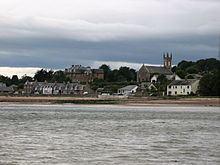OS grid reference NH736577 Postcode district IV10 8 Local time Wednesday 9:34 PM | Council area Highland | |
 | ||
Weather 3°C, Wind E at 8 km/h, 80% Humidity | ||
Fortrose rosemarkie 4th hole
Rosemarkie (Scots: Rossmartnie, from Scottish Gaelic: Ros Mhaircnidh meaning "promontory of the horse stream") is a village on the south coast of the Black Isle peninsula in Ross-shire (Ross and Cromarty), northern Scotland.
Contents
- Fortrose rosemarkie 4th hole
- Map of Rosemarkie Fortrose UK
- Dolphins in rosemarkie scotland
- Geography
- Pictish stones
- References
Map of Rosemarkie, Fortrose, UK
Dolphins in rosemarkie scotland
Geography
Rosemarkie lies a quarter of a mile east of the town of Fortrose. The pair make up the Royal Burgh Of Fortrose and Rosemarkie, situated either side of the Chanonry Ness promontory, about twelve miles north-east of Inverness.
Rosemarkie fronts on a wide, picturesque bay, with views of Fort George and the Moray coastline across the Moray Firth. Rosemarkie has one of the finest beaches on the Moray Firth Coast Line. At the southern end of the beach is Chanonry Point, reputed to be the best location on the United Kingdom mainland from which to see dolphins.
Rosemarkie is linked to Inverness by fairly irregular bus services, which are provided by Stagecoach Group.
Pictish stones
Rosemarkie is probably best known for its collection of finely carved Pictish stones, which is one of the largest in Scotland at a single site. These 8th-9th-century sculptures, found in and around the town's churchyard, are displayed in the Groam House Museum, a converted 18th-century town-house on the High Street. The house is open in summer and charges a small entrance fee. These carved stones are evidence for a major early monastery at Rosemarkie, founded by, or associated with, Saint Moluag (d. 592) and Boniface, otherwise known as Curetán (fl. early 8th century). The sculptures include cross-slabs, shrine fragments and architectural pieces. One small fragment of a stone from Rosemarkie is in the Museum of Scotland in Edinburgh.
